Just after midnight on April 5 and only 12 hours after being flow in and dropped off on the glacier, Ben Erdmann, Jess Roskelley and Kristoffer Szilas began ascending the east face of The Citadel in Alaska’s Kichatna Range. The intriguing and obvious route, Hypa Zypa Couloir (VI 5.10R A3 AI5+ M6+, 3,700′), climbs a difficult couloir terminating at a col below a sub-summit where a traverse along the ridge brought the climbers to the true apex of The Citadel (8,520′).
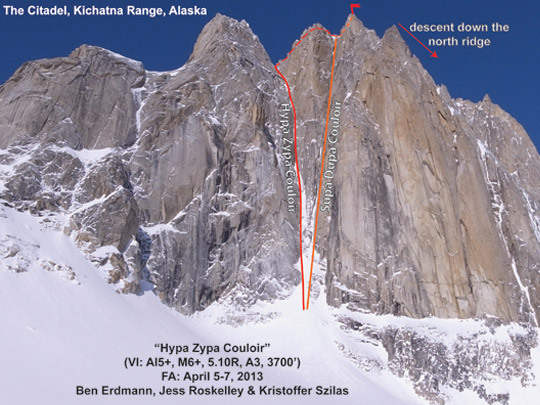
Routeline showing Hypa Zypa (VI 5.10R A3 AI5+ M6+, 3,700′) and Super Dupa (ED4: WI6+, 3,700′), The Citadel (8,520′), Kichatna Range. The climbers gave Hypa Zypa an NCCS grade VI in part for the commitment. “Descending our route would have been extremely difficult due to the lack of cracks in the lower wall and/or thick enough ice for v-threads,” Roskelley said. “You’d have to bail up it [to get down].” [Photo] Kristoffer Szilas
In 1976, David Black, Mike Graber, Andy Embick and Alan Long made the first ascent of peak’s east face via the east buttress (VI 5.9 A3). Fixing ropes and sleeping in hammocks, the party spent six days on the wall and climbed 33 pitches total, reaching the summit on June 28. Long remembers “one-swing nailing, incredible exposure” in his account in the 1977 American Alpine Journal. They climbed in two parties, allowing the off-team to rest their arms and nurse their wounds, while the hammocks tortured their backs. “This is the beauty of a four-man party: your involvement with the actual climbing decreases and the often-welcome distraction of pitons and pitches disappears for hours at a time, but a feeling of security emerges and endures through even the most trying situations,” wrote Long. A complex descent required down climbing a couloir, eight rappels and two bergschrunds, interrupted briefly by a snow storm. When they finally made it back to camp, they’d been moving for 75 hours, with just nine hours of rest.
This month, plans were in place for Erdmann, Roskelley and Szilas to land on the Shadows Glacier of the Kichatna Range and repeat Super Dupa Couloir (ED4: WI6+, 3,700′), a technical line established in 2003 by Mike “Twid” Turner, Stu McAleese and Olly Sanders on The Citadel. But after receiving information from Turner about a possible line near Super Dupa, ambitions changed.
Turner’s information held true. To the left of Super Dupa Couloir lay another aesthetic line. On April 5, the initial pitches of Hypa Zypa climbed through snow and ice and eventually led to a steep corner system with difficulties reaching AI5+ and M6+. As the sun set, the trio chopped into a steep ice slope making an area just large enough for a cold sitting bivy. The tent they carried with them was too small for the ledge they created and collapsed in the night.
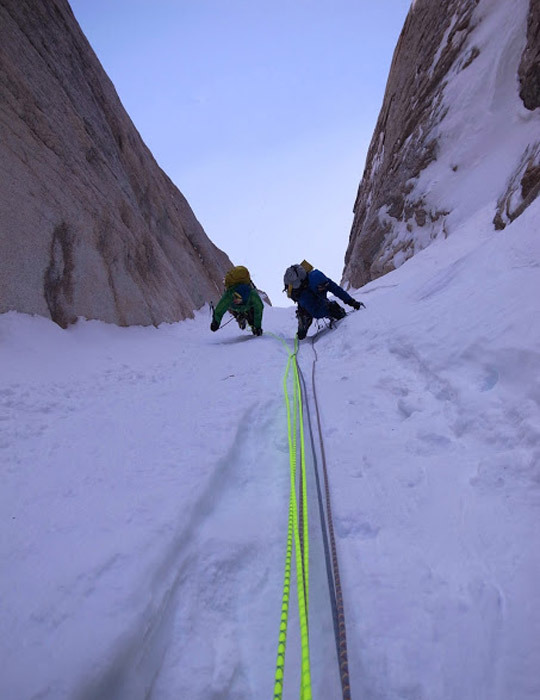
Ben Erdmann and Jess Roskelley climb steep snow low on the route. [Photo] Kristoffer Szilas
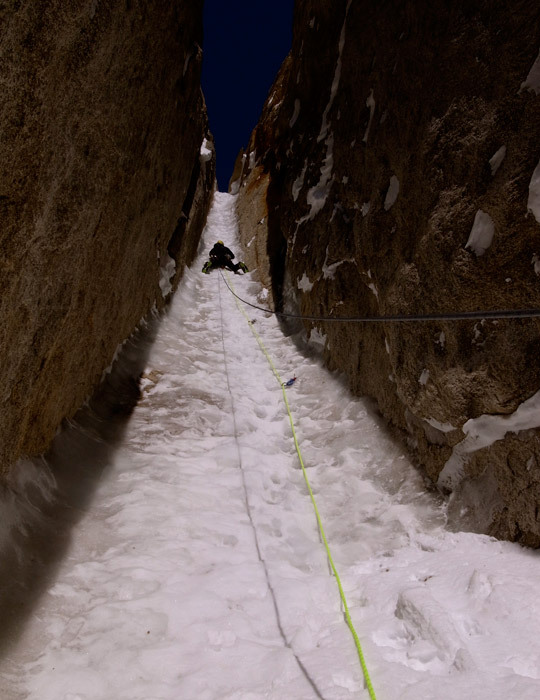
Jess Roskelley leads the crux ice pitch. Hypa Zypa is one of two obvious couloirs on the east face of the Citadel. Super Dupa Couloir (ED4: WI6+, 3,700′) was established a decade ago by Mike “Twid” Turner, Stu McAleese and Olly Sanders. [Photo] Kristoffer Szilas
Waking up early, the team continued up to the col on the southeast ridge. Erdmann took the sharp end on a steep A3 section of rock and continued through the crux 5.10R pitch without crampons or gloves, pulling out a full 60m of rope. Reaching the summit ridge that evening, they set up another bivy “a stone’s throw from the actual summit,” and hunkered down for another cold night on a chopped ice ledge.
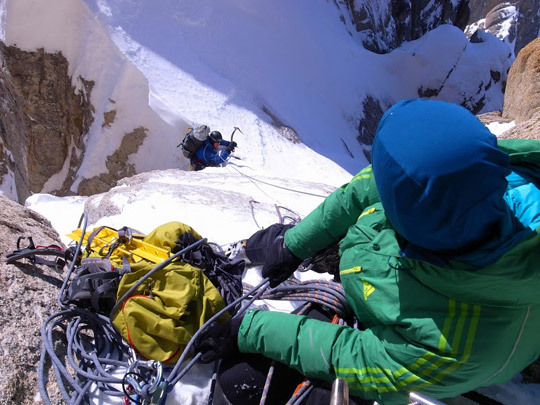
Reaching the col to exit the east face of The Citadel before starting up an A3 pitch on the ridge. [Photo] Kristoffer Szilas

Erdmann and Roskelley on the snow slope leading to the summit of The Citadel with the Kichatna Spire behind. [Photo] Kristoffer Szilas
The next morning, the trio made a short rappel down the west face of the sub-peak to a snow ramp leading directly to the summit. After a quick rest on top, they descended the north ridge, getting their ropes stuck several times, down climbing many sections of exposed rock and rappelling from their only two snow stakes. They made a final rappel over the bergschrund on a flexing Spectre hammered less than three centimeters into an icy crack. The trio stumbled back to their tents, completing Hypa Zypa over a 70-hour push camp to camp.
Assessing their route afterward, the climbers gave Hypa Zypa an NCCS grade VI out of VII because of the ascent time, sustained technical difficulty, remoteness and commitment. “Descending our route would have been extremely difficult due to the lack of cracks in the lower wall and/or thick enough ice for v-threads,” Roskelley said. “You’d have to bail up it [to get down].”
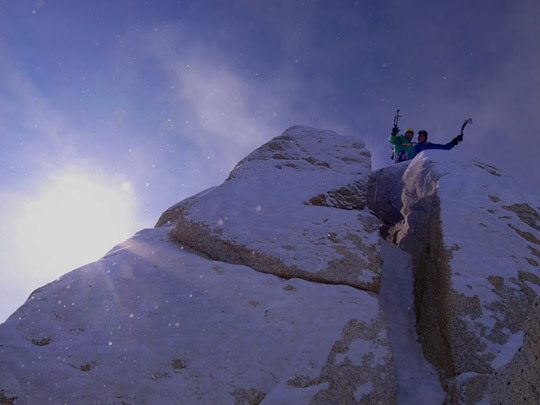
Jess Roskelley and Ben Erdmann on the summit of The Citadel. [Photo] Kristoffer Szilas
Back at home, Erdmann wrote, “How good it feels to be back to the world of humans and warmth, the first of many Bikram Yoga sessions to work the cold from protesting digits and getting food in the system that’s NOT fried in bacon grease.”